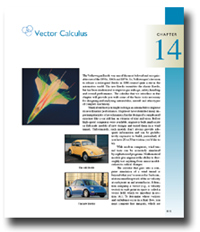 <a onClick="window.open('/olcweb/cgi/pluginpop.cgi?it=jpg::::/sites/dl/free/0219532320/295036/ch14.jpg','popWin', 'width=NaN,height=NaN,resizable,scrollbars');" href="#"><img valign="absmiddle" height="16" width="16" border="0" src="/olcweb/styles/shared/linkicons/image.gif"> (23.0K)</a> <a onClick="window.open('/olcweb/cgi/pluginpop.cgi?it=jpg::::/sites/dl/free/0219532320/295036/ch14.jpg','popWin', 'width=NaN,height=NaN,resizable,scrollbars');" href="#"><img valign="absmiddle" height="16" width="16" border="0" src="/olcweb/styles/shared/linkicons/image.gif"> (23.0K)</a> | The Volkswagen Beetle was one of the most beloved and recognizable cars of the 1950s, 1960s and 1970s. So, Volkswagen's decision to release a redesigned Beetle in 1998 created quite a stir in the automotive world. The new Beetle resembles the classic Beetle, but has been modernized to improve gas mileage, safety, handling and overall performance. The calculus that we introduce in this chapter will provide you with some of the basic tools necessary for designing and analyzing automobiles, aircraft and other types of complex machinery.
Think about how you might redesign an automobile to improve its aerodynamic performance. Engineers have identified many important principles of aerodynamics, but the design of a complicated structure like a car still has an element of trial and error. Before high-speed computers were available, engineers built small-scale or full-scale models of new designs and tested them in a wind tunnel. Unfortunately, such models don't always provide adequate information and can be prohibitively expensive to build, particularly if you have 20 or 30 new ideas you'd like to try.
With modern computers, wind tunnel tests can be accurately simulated by sophisticated programs. Mathematical models give engineers the ability to thoroughly test anything from minor modifications to radical changes.
The calculus that goes into a computer simulation of a wind tunnel is beyond what you've seen so far. Such simulations must keep track of the air velocity at each point on and around a car. A function assigning a vector (e.g., a velocity vector) to each point in space is called a vector field, which we introduce in section 14.1. To determine where vortices and turbulence occur in a fluid flow, you must compute line integrals, which are discussed in sections 14.2 and 14.3. The curl and divergence, introduced in section 14.5, allow you to analyze the rotational and linear properties of a fluid flow. Other properties of three-dimensional objects, such as mass and moments of inertia for a thin shell (such as a dome of a building), require the evaluation of surface integrals, which we develop in section 14.6. The relationships among line integrals, surface integrals, double integrals and triple integrals are explored in the remaining sections of the chapter.
In the case of the redesigned Volkswagen Beetle, computer simulations resulted in numerous improvements over the original. One measure of a vehicle's aerodynamic efficiency is its drag coefficient. Without getting into the technicalities, the lower its drag coefficient is, the less the velocity of the car is reduced by air resistance. The original Beetle has a drag coefficient of 0.46 (as reported by Robertson and Crowe in Engineering Fluid Mechanics). By comparison, a low-slung (and quite aerodynamic) 1985 Chevrolet Corvette has a drag coefficient of 0.34. Volkswagen's specification sheet for the new Beetle lists a drag coefficient of 0.38, representing a considerable reduction in air drag from the original Beetle. Through careful mathematical analysis, Volkswagen improved the performance of the Beetle while retaining the distinctive shape of the original car. |





